
The Tuchel district was a Prussian district in Germany that existed from 1875 to 1920. It was in the part of West Prussia that fell to Poland after World War I through the Treaty of Versailles. Its capital was Tuchel.

The Tuchel district was a Prussian district in Germany that existed from 1875 to 1920. It was in the part of West Prussia that fell to Poland after World War I through the Treaty of Versailles. Its capital was Tuchel.
The area of the Tuchel district was annexed by the Kingdom of Prussia through the First Partition of Poland in 1772 and was part of the Konitz district. On 30 April 1815, the area became part of the new administrative region of Marienwerder in the province of West Prussia. From 3 December 1829 to 1 April 1878, West Prussia and East Prussia were united to form the Province of Prussia, which had belonged to the German Reich since 1871.
Due to the steady population growth in the 19th century, several districts proved to be too large and a reduction in size was necessary. Therefore, in 1875, the new Tuchel district was created from parts of the Konitz district. The district office was set up in the town of Tuchel (Tuchola). As a result of the Versailles Treaty, the district had to be ceded by Germany to Poland on 10 January 1920.
The Tuchel district had a majority Polish population with a significant German minority.
| Year | Population | German | Polish / Bilingual / Other | ||
|---|---|---|---|---|---|
| 1905 | 30,803 | 9,925 | 32.2% | 20,878 | 67.8% |
| 1910 | 33,951 | 11,265 | 33.2% | 22,686 | 66.8% |
In the German Empire, the Tuchel district together with the Konitz district formed the Reichstag constituency of Marienwerder 6. This constituency was won by candidates from the Polish Party in all elections to the Reichstag between 1871 and 1912.
In 1912, the Tuchel district included the town of Tuchel and 54 rural communities: [2]
|
|
|
|

After the German invasion of Poland, the district became part of the newly formed Reichsgau Danzig-West Prussia - in the administrative region of Bromberg. The town of Tuchel was subject to the German municipal code of 30 January 1935, which was valid in the Altreich and provided for the implementation of the Führerprinzip at the municipal level.
On 25 June 1942 all place names were Germanized. Either the name from 1918 was retained or - if "not German" enough - acoustically adjusted or translated, for example:

The Marienwerder Region was a government region (Regierungsbezirk) of Prussia from 1815 until 1920 and again 1939-1945. It was a part of the Province of West Prussia from 1815 to 1829, and again 1878–1920, belonging to the Province of Prussia in the intervening years, and to the Reichsgau Danzig-West Prussia in the years 1939-1945. The regional capital was Marienwerder in West Prussia.

Tuchola is a town in the Kuyavian-Pomeranian Voivodeship in northern Poland. The Pomeranian town, which is the seat of Tuchola County, had a population of 13,418 as of 2013.

Kreis Birnbaum was a district in Prussia (Kreis) in the west of the Grand Duchy of Posen and the succeeding Province of Posen, as part of Regierungsbezirk Posen between 1815 and 1920. Today the area belongs to the Polish voivodeships of Greater Poland and Lubusz.
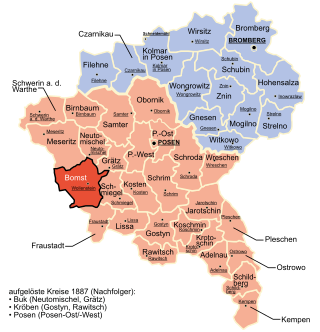
The district of Bomst was a Prussian district which existed from 1793 to 1807 in the province of South Prussia and from 1815 to 1938 successively in the Grand Duchy of Posen, the Province of Posen and the Frontier March of Posen-West Prussia. The district capital was Wollstein.

Kreis Samter was a district in Regierungsbezirk Posen, in the Prussian Province of Posen from 1818 to 1918. Its territory presently lies in the north-western part of Polish region of Greater Poland Voivodeship.
The Administration of West Prussia before 1919 consisted of the following officials:
Nowa Tuchola is a settlement, part of the village of Mały Mędromierz in the administrative district of Gmina Tuchola, within Tuchola County, Kuyavian-Pomeranian Voivodeship, in north-central Poland.

The Flatow district was a district that existed from 1818 to 1945 in the Kingdom of Prussia and Germany. It belonged to the province of West Prussia until 1920. After World War I, the eastern portion of the district was ceded to Poland. The western portion of the district remained in Germany and became part of the Frontier March of Posen-West Prussia until 1938. The district then became part of the Province of Pomerania from 1938 to 1945. Today the territory of the Flatow district lies in the Kuyavian-Pomeranian Voivodeship and the Greater Poland Voivodeship in Poland.
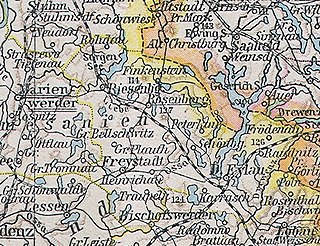
The district of Rosenberg in Westpreußen was a Prussian district that existed from 1818 to 1945. The territory of the district is now located within the Polish Warmian-Masurian Voivodeship.
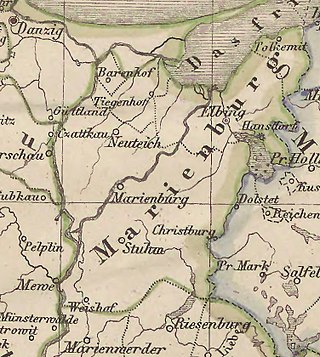
The Marienburg district was a Prussian district that existed from 1772 to 1945. The district originally belonged to the province of West Prussia and was divided in 1920 by the Treaty of Versailles. Its western half fell to the Free City of Danzig, while its eastern half became part of the province of East Prussia and remained in the German Reich until 1945. The district capital was Marienburg. The territory of the district is now part of the Pomeranian Voivodeship in Poland.
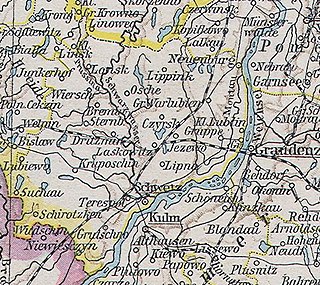
Kreis Schwetz was a Prussian district that existed from 1818 to 1920, with its capital at Schwetz. The district was located on the western bank of the Vistula river in the part of West Prussia that fell to Poland after the First World War through the Treaty of Versailles in 1920.
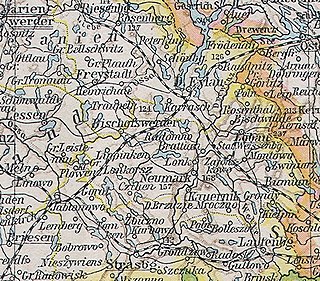
The Löbau district was a Prussian district in the Marienwerder administrative region that existed from 1818 to 1920. The seat of the district administration was in the city of Neumark. The district belonged to the part of West Prussia that fell to Poland after World War I through the Treaty of Versailles in 1920. Today, the territory of the district is in the Warmian-Masurian Voivodeship in Poland.

The district of Kulm was a Prussian district in the Marienwerder administrative region, which existed from 1772 to 1920. The district capital was Kulm. Today the territory of the district lies in the Kuyavian-Pomeranian Voivodeship in Poland.

The district of Deutsch Krone was a district in Prussia from 1772 to 1945. It belonged to the part of West Prussia that remained in the German Reich after World War I and became part of the Province of Grenzmark Posen-West Prussia. From 1938 to 1945, it belonged to the Province of Pomerania. Today the territory of the district area lies in the Polish Voivodeships of West Pomerania and Greater Poland.

The district of Graudenz was a Prussian district in the administrative region of Marienwerder that existed from 1818 to 1920. It belonged to the province of West Prussia until 1829 and then again from 1878 to 1920. Between 1829 and 1878, it belonged to the Province of Prussia. It was located in the part of West Prussia that fell to Poland after the World War I in 1920 through the Treaty of Versailles. The city of Graudenz, was part of the district until 1900, after which it formed its own independent urban district.
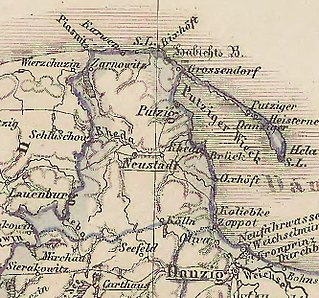
The Neustadt district was a Prussian district that existed from 1818 to 1920. It was in the part of West Prussia that fell to Poland after World War I through the Treaty of Versailles. From 1939 to 1945 the district was re-established in occupied Poland as part of the Reichsgau Danzig-West Prussia. Today the area of the former district is in the Polish Pomeranian Voivodeship.

The Berent district was a Prussian district that existed from 1818 to 1920. It was in the part of West Prussia that fell to Poland after World War I in 1920. Its capital was Berent. From 1939 to 1945, the district was re-established in German-occupied Poland as part of the newly established Reichsgau Danzig-West Prussia. Today the territory of the district is located in the Polish Pomeranian Voivodeship.

The district of Thorn was a Prussian district in the Marienwerder administrative region that existed from 1818 to 1920. It belonged to the province of West Prussia, except for the period from 1829 to 1878 when it was part of the Province of Prussia. Its capital was Thorn. It was in the part of West Prussia that fell to Poland after World War I in 1920 through the Treaty of Versailles. From 1939 to 1945, the district of Thorn was re-established in Reichsgau Danzig-West Prussia in occupied Poland. Today, the area of the district is in the Kuyavian-Pomeranian Voivodeship in Poland.

The Preußisch Stargard district was a Prussian district that existed from 1772 to 1920 with varying borders. It was in the part of West Prussia that fell to Poland after World War I through the Treaty of Versailles in 1920. Its county seat was Preußisch Stargard. From 1939 to 1945 the district was re-established in German-occupied Poland as part of the newly established Reichsgau Danzig-West Prussia. Today the territory of the district is located in the Polish Pomeranian Voivodeship.
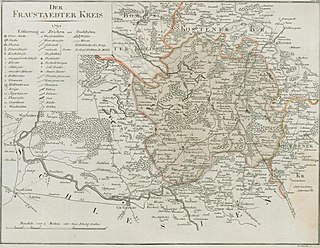
The Fraustadt district was Prussian district which existed in various borders from 1793 to 1945. From 1793 to 1807 it was located in the Province of South Prussia, from 1815 to 1848 in the Grand Duchy of Posen, from 1848 to 1920 in the Province of Posen, from 1922 to 1938, in the Province of Posen-West Prussia, from 1938 to 1941 in the Province of Silesia and from 1941 to 1945 in the Province of Lower Silesia.